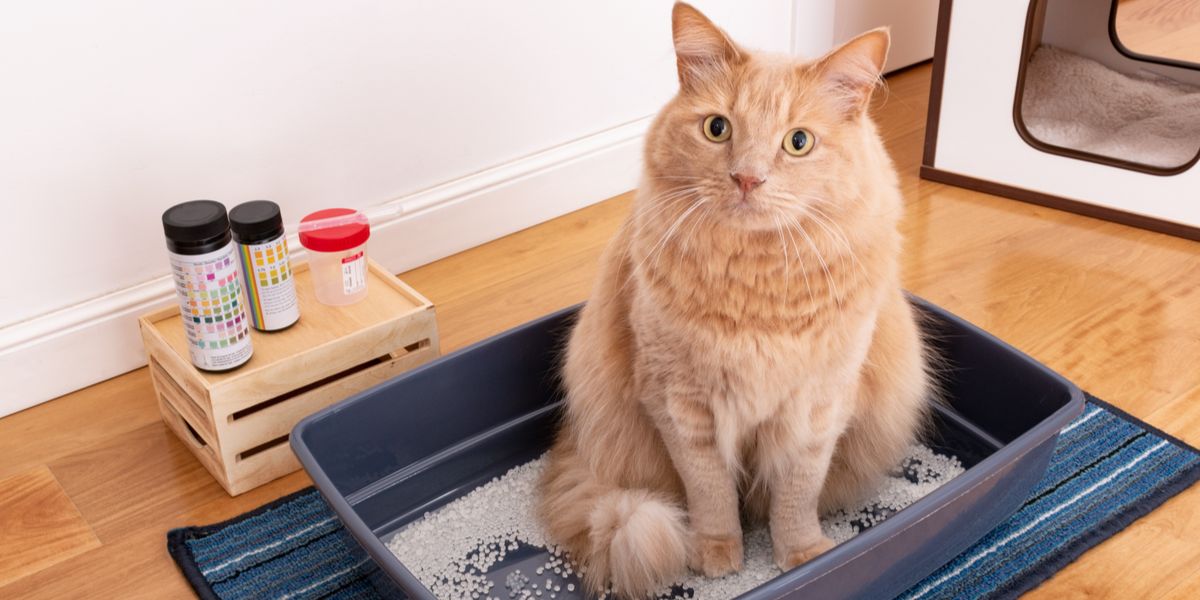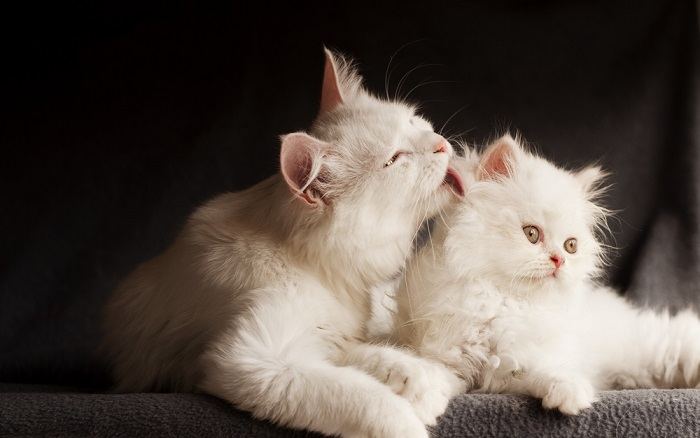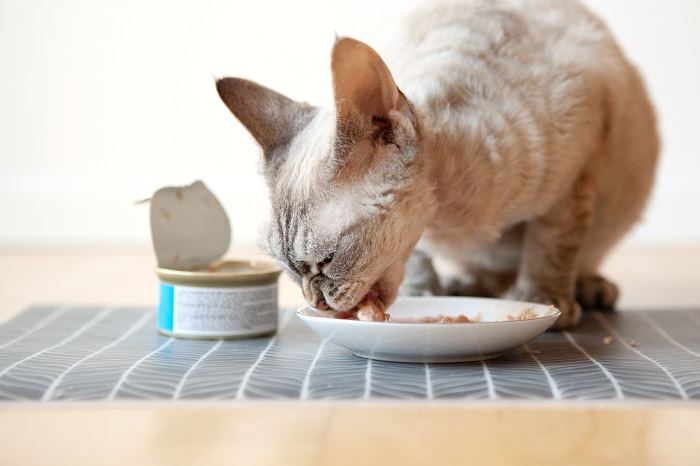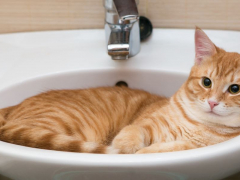
Polycystic kidney disease (PKD), or to give it its full name, autosomal dominant polycystic kidney disease (AD-PKD), is an inherited disease in cats that causes abnormal cysts (fluid filled sacs) to form in a cat’s kidneys.
These cysts are present from birth in affected cats, but initially they are so small that they don’t cause an issue. However, over time (usually several years) the cysts grow in both size and number, causing damage to the healthy tissue of the kidneys. This affects kidney function and can eventually lead to irreversible kidney failure.
The rate at which the disease progresses is very variable, with many cats not showing any symptoms until their more senior years, or at all. However, in other cases it can progress much more quickly, and even young cats can show signs of serious renal disease.
What Are the Symptoms of Polycystic Kidney Disease in Cats?
The cysts in the kidneys do not cause any symptoms until they are large enough to cause damage to the kidney tissue, affecting how the kidneys function. The average age this starts to happen is 7 years of age, but it can range from around 3 to 10 years of age.
Once the function of the kidneys is affected, the signs we see are the same as chronic kidney disease in cats. It isn’t possible to identify PKD as the underlying cause without performing further tests.
Clinical signs of kidney disease in cats include:
- Weight loss
- Increased drinking (polydipsia)
- Increased urinating (polyuria)
- Lethargy
- Poor appetite
- Poor coat
- Vomiting
- Diarrhea
These symptoms overlap with an array of conditions but a simple two-minute test can help you determine whether your cat’s kidneys might be involved. Click here to learn more about Kidney-Chek, an at-home saliva test that helps assess kidney function.
What Causes Polycystic Kidney Disease in Cats?

Polycystic kidney disease is an inherited disease that is common in Persian cats and some other breeds.
Polycystic kidney disease is an inherited—or genetic—disease in cats, meaning it is passed on to them by their parents. It is thought to be the most common inherited disease we see in cats, with around 6% of all cats being affected.
However, it is seen most frequently in Persian cats and related breeds, with some studies finding that nearly half of all Persian cats suffer from the condition.
Other breeds frequently affected include the Exotic Shorthair cats, British Shorthair cats, and to a lesser extent Ragdolls, Rex breeds, Himalayans, and Birmans.
Research has identified the mutated gene we think is responsible for causing the disease, called PKD1. Approximately 90% of cats carrying this mutated gene will have renal cysts within their lifetime.
A DNA test is available for cats and kittens that can check for the mutated PKD1 gene using a blood sample or cheek swab.
Cats who have been tested and found negative for the gene can be found on the AD-PKD Negative Register, allowing breeders and prospective new owners to check the status of the parents of potential new kittens. Since genetic testing has been available, the incidence of PKD in cats has been falling.
If you are interested in buying a kitten from a breed that commonly suffers from PKD (such as a Persian kitten), it is important to check that they are not carrying the mutated PKD1 gene. Your veterinarian will be able to discuss genetic testing with you.
How Do You Diagnose Polycystic Kidney Disease in Cats?
If you are worried your cat might have polycystic kidney disease, the first step is to take them to your veterinarian.
Your veterinarian will perform a full physical examination, including feeling the size and shape of your cat’s kidneys to check for abnormalities. They will also take a thorough history, including asking about your cat’s drinking, appetite, and urination.
The next step is usually comprehensive blood tests to assess your cat’s kidney function, in particular, urea and creatinine levels. Blood tests will also check for secondary effects of kidney disease, such as anemia. Your vet will also need to look at a sample of your cat’s urine to check for bacteria, protein, and white blood cells, and to assess if the urine is well concentrated.
However, to identify PKD as the cause of a kidney problem, your veterinarian will need to perform imaging. This is most commonly an ultrasound scan of your cat’s kidneys to look for the characteristic renal cysts found in PKD.
How Do You Treat Polycystic Kidney Disease in Cats?

Cats diagnosed with polycystic kidney disease need to eat a special kidney-support diet.
Unfortunately, there is no specific treatment for polycystic kidney disease in cats. As affected cats grow older, the cysts will increase in size and number. Currently there is no treatment available to stop or slow this process.
Treatment is the same as for chronic kidney disease in cats. One of the most effective treatments for supporting cats with kidney disease is a special prescription diet which has the best balance of phosphorous, protein, and salt to support their kidney function.
Depending on the results of further tests, your veterinarian may also recommend medications to reduce absorption of phosphorous from the diet, supplement potassium, and possibly tablets to lower your cat’s blood pressure if it is high.
As the disease progresses, palliative care, such as fluid therapy or anti-nausea medication, can really help your cat to feel as well as possible.
The rate at which PKD progresses is very variable in cats. Sadly, in cats who are very badly affected, the disease will eventually progress to cause renal failure. Your veterinarian can support you in assessing your cat’s quality of life and knowing when euthanasia might be the kindest decision.
Frequently Asked Questions
How long do cats with polycystic kidney disease live?
As polycystic kidney disease is an inherited condition, affects cats are born with tiny cysts already present in their kidneys. However, the rate at which these cysts grow and begin to cause problems is highly variable.
The average age of onset of symptoms is around 7 years, but it can vary from approximately 3 to 10 years. Some cats with very small cysts that grow slowly may never show signs of illness within their lifetime.
Just as the age at which we first see signs of PKD is variable, so is the progression of the disease from this point. Some cats with slow progression may live for many years after diagnosis, particularly with appropriate treatment. In other cases, it can progress very fast (just weeks to months after diagnosis).
Once your cat has been diagnosed, your veterinarian will recommend appropriate treatment and regular monitoring of their kidney function.
Is polycystic kidney disease treatable in cats?
There is no specific treatment for polycystic kidney disease in cats, and unfortunately, we cannot stop the disease from progressing.
However, we treat the kidney damage caused by the cysts in the same way as chronic kidney disease in cats. The mainstay of this treatment is a special renal diet, which provides the best balance of sodium, phosphorous, and protein to help the kidneys function. Some cats may also benefit from medications to lower their blood pressure (if it is high), reduce the amount of phosphate they absorb from their food, and to supplement their potassium levels.
Later on in the disease, palliative treatments like fluid therapy, anti-nausea medication and appetite stimulants can all help maintain a good quality of life.
All these treatments will help your cat stay as well as possible for as long as possible, but there are no treatments that can cure polycystic kidney disease or prevent its progression.
What are the symptoms of polycystic kidney disease in cats?
The symptoms of polycystic kidney disease in cats are not specific for PKD (which is usually diagnosed by seeing cysts within the kidneys using ultrasonography), but are the same as chronic kidney disease.
Cats affected by chronic kidney disease will often drink more, urinate more, lose weight, and may have poor appetite and energy levels. They may also suffer from vomiting and diarrhea.
What causes polycystic kidney disease in cats?
Polycystic kidney disease is an inherited (genetic) disease in cats caused by a mutation in the PKD1 gene. There are genetic tests now for both breeding parents and kittens which can identify if they are carrying this gene. Since genetic testing has become available, the number of cats affected by PKD has been declining.
If you are thinking of purchasing a kitten of a cat breed that is commonly affected by PKD (such as Persian-related cats) it is important to find out if the parents have been tested. Your veterinarian can help you with finding out more about DNA testing.
-
Schirrer, L.; Marín-García, P.J.; Llobat, L. Feline Polycystic Kidney Disease: An Update. Vet. Sci. 2021, 8, 269. https://doi.org/10.3390/vetsci8110269








Our cat was recently diagnosed with proteinuria
Too much protein is being filtered out. So he has been losing weight approx 1lbs in a year he is 11lbs now and 14 year old tabi. Generally very happy his poops and pees were regular but he started vomiting so we took him to the vet. 1000 dollars later he was prescribed a hypoallergenic wet food and kibble and fortekor to shrink the filter and his kidneys so he doesn’t lose too much protein. Apparently all his other levels were normal, so this was the recommended solution.. unfortunately, our cat is still vomiting and has developed diarrhea. So the vet instructed us to stop the medication to see if any changes happened after a couple of days the diarrhea was still happening so we removed the kibble and only have him on wet food, and that appears to have helped.. personally, I think the dosage is a bit too high, 1.25 mg for the medication as these were pills for dogs that we were instructed to cut into quarters .. one thing we have noticed is since we stopped, giving him the medication. He is actually sleeping with us and a lot more sociable.. it has been a week since he last vomited but this morning he start up a little bit of fluid. I fed him and he probably ate so might have been that he was hungry.? so my question is what to do now
Hello Kim, apologies for the late reply! I would recommend taking this question to the All About Cats Community forum, where a qualified veterinarian will be able to give you better advice.